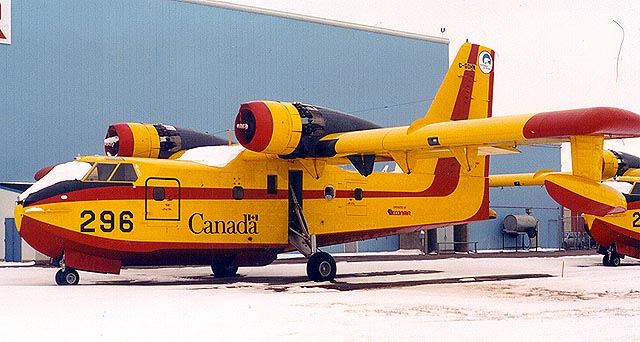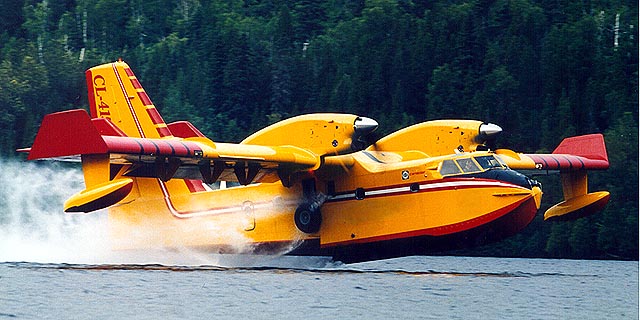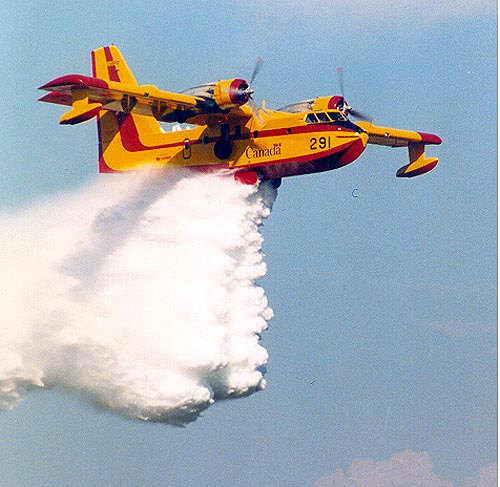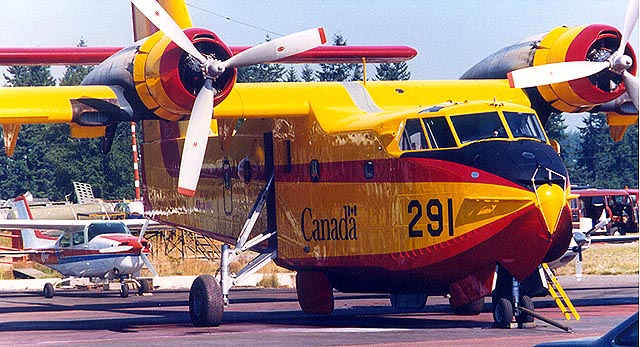Skip to comments.
U.S. Won't Use Air Tankers for Wildfires
The Guardian (U.K.) ^
| May 10, 2004
| IRA DREYFUSS
Posted on 05/10/2004 11:14:43 PM PDT by Stoat
WASHINGTON (AP) - Just as the 2004 wildfire season is opening, the government on Monday grounded an aging fleet of 33 former military tankers that had been among the biggest weapons in its arsenal for fighting the blazes.
The Forest Service and the Interior Department terminated contracts with private companies for use of the planes after the National Transportation Safety Board determined their airworthiness could be not assured. Three such planes crashed between 1994 and 2002, killing seven crew members.
Forest Service Chief Dale Bosworth said that, in the wake of the NTSB report, continuing to use the tankers posed ``an unacceptable risk'' to aviators, ground firefighters and communities near the blazes.
The fixed-wing planes, some of them as old as 60 years, had been used primarily in initial attacks on fires and protecting buildings when fires were moving toward urban areas, said Dan Jiron, a spokesman for the Forest Service.
He said the government still has the use of 491 other aircraft, including smaller fixed-wing planes and helicopters. ``It's serious, but we will be able to do our job,'' Jiron said.
The tankers were each capable of dumping from 1,700 to 2,500 gallons of water a minute.
The Forest Service grounded the fleet of tankers it had under contract after two crashes in 2002.
The planes were reactivated after a new inspection program was developed at the Energy Department's Sandia National Laboratory in Albuquerque, N.M., but the NTSB said in its report last month that maintenance and inspection programs were still inadequate.
``It was apparent that no effective mechanism currently exists to ensure the continuing airworthinesss of these firefighting aircraft,'' the report said.
Complete information on the stresses that the planes endured in firefighting was not available, the report said. Nor was there complete information on maintenance and inspection dating back to the planes' use in the military.
Investigators who reviewed the crashes in California and Colorado in 2002 said the aircrafts' wings could not take the strain. In the California crash involving a C-130A, the wings snapped off and the fuselage plunged to the ground, killing three people on board.
Planes from the now-grounded fleet probably were used to fight a current fire in California, Jiron said. ``We always use what fleet we have available to use,'' he said.
However, the planes were not used on Monday, he said.
Fires also are burning in Montana, Arizona and Minnesota. They are fueled by drought, which has been worsening in many areas in the West, drying pasturelands and leaving forests parched. The National Drought Mitigation Center's Drought Monitor now classifies the West as being in a state of exceptional drought, worse than its initial classification of abnormally dry.
The government will have to shift firefighting tactics with the loss of the 33 planes, Jiron said.
Firefighters will target blazes with helicopters and cropduster-type fixed-wing aircraft, Jiron said. These aircraft can be more accurate than the big planes when they drop their payloads, and they can resupply with water closer to the fire, he said.
The government also can activate eight military C130s equipped to carry water, he said.
``This is a loss, but it is not something we can't address now that the curtain is raising on fire season,'' Jiron said.
To the government, the loss of planes is not an insurmountable problem. Firefighters still should be able to do their inherently dangerous job ``with or without air support,'' it said.
But one aviation officer in the Forest Service, Bill Pierce, called the grounding of the 33 tankers ``a major loss'' that could raise the risks involved with firefighting.
``It's a real hazardous situation, not having the tankers,'' said Pierce of the Humboldt-Toiyabe Forest Service office in Reno, Nev.
TOPICS: Breaking News; Business/Economy; Crime/Corruption; Culture/Society; Foreign Affairs; Government; Miscellaneous; News/Current Events
KEYWORDS: environmentalism; government; supertankers; usforestservice; wildfires
Navigation: use the links below to view more comments.
first previous 1-20, 21-40, 41-60, 61-80, 81-87 next last
To: Stoat
The convicts stay in their camp while the other wildland firefighters are assigned their area. The work is still hard and isn't anything I would want to do for a long period of time.. It is very tough and should be respected. Unfortunately, their is a class of people in this country who haven't slung a hoe or worked a blister on their pinky who look down on rescue personnel... of all things... but, they have money, and little brains, easy sheep... helps the economy go round.
21
posted on
05/11/2004 12:50:54 AM PDT
by
Porterville
(Kerry has no gravitas!!!)
To: HiTech RedNeck
That's one of the best ideas I've seen on FR in about a year. Excellent thinking!
22
posted on
05/11/2004 4:44:59 AM PDT
by
taxed2death
(A few billion here, a few trillion there...we're all friends right?)
To: Stoat
The
Martin Mars was retired a couple of years ago in Canada.
Firefighting certainly wasn't what Glenn L. Martin had in mind for the design of the Martin Mars. Originally conceived as a bomber for long range missions and patrols, the production aircraft were redesigned and classified for long-range general transport because of the demonstrated heavy-lift capability of the prototype. The "Big Four", as they were affectionately known, established airlift and endurance records which remain valid today and they logged some 87,000 accident-free hours before being retired by the USN and sold to Flying Tankers. Mr. Martin would be very pleased to know his original intention of the Mars in a bomber role came to pass in their second career as waterbombers.

Philippine Mars
White Tail - side drop system
Canadian Registration C-FLYK
S/N 76820

Red Tail - bottom drop system
Canadian Registration C-FLYL
S/N 76823
During the fire season, the aircraft are kept in a state of readiness to meet the existing fire hazard conditions. They can be in the air in ten minutes and, based on historical data, each can make a drop every fifteen minutes. Working in tandem, this equates to 7,200 US gallons (27,276 litres) every seven minutes and each drop can cover an area of up to 4 acres (1.6 hectares). It has often been said that the Mars, with a 60,000 pound (27,216 kilogram) payload of foam, is like "hand-grenades or horseshoes - close is good enough" but such is not the case. The highly experienced Mars pilots, working closely with the fire boss, deliver the water or foam right where it is needed.
Each Mars carries 600 US gallons (2,270 litres) of foam concentrate - enough for 21 drops of a 0.4% solution which is the standard used although it may be decided to use more or less foam as dictated by the Fire Boss.
23
posted on
05/11/2004 5:02:26 AM PDT
by
OrioleFan
(Republicans believe every day is July 4th, DemocRATs believe every day is April 15th. - Reagan)
To: Stoat
Your list appeals to me emotionally, but I would alter #3 and #4 ever so slightly.
Environmental groups have been suing the various agencies responsible for public land management for decades. As a result, the scarce financial resources have been diverted into the legal defense effort and away from the forests where they're most needed. I'd sue the enviro groups for tying the hands of USFS/BLM/et al and preventing them from doing their job.
24
posted on
05/11/2004 5:11:42 AM PDT
by
Lil'freeper
(The enemy's gate is down!)
To: Carry_Okie
Didnt the Russians just develope a humongous air tanker that we were thinking of buying some time ago?
25
posted on
05/11/2004 5:48:44 AM PDT
by
Husker24
To: DryFly
My wife works for the TV station that caught that video. It was a busy day after that as just about every station across the country called asking for a copy of the video.
26
posted on
05/11/2004 6:05:17 AM PDT
by
randog
(Everything works great 'til the current flows.)
To: Stoat
I think we need a huge fleet of these:
(Ignore the fact that they're 'canadian')
|
Air Power
Canadair CL-215/415 "Super Scooper"
 |
The Canadair CL-215 was the first aircraft ever designed specifically for Water Bombing. While the PBY Canso was modified from it’s role as a military submarine patrol aircraft, the CL-215 was created as an actual Water Bomber.
After departing the airport, the CL-215 crew of two heads directly for a suitable ‘scooping’ lake as close to the forest fire as possible. An inspection run is made on the lake to insure that it is of suitable length and has no obstructions which could hamper the safety of the aircraft and flight crew. The aircraft then touches down on the lake and ‘scoops’ 12000 lbs of water into the internal tanks within ten seconds. At this point the water pickup probes are retracted and the aircraft leaps into the air, heading towards the fire. The Air Attack Officer on board the birddog aircraft instructs the water bomber flight crew where and how to drop the load. He may ask that the crew inject a harmless soap-like solution into the water tanks through an onboard computer. This will give the water a foam-like consistency to help increase it’s holding time at the fire. As there are two water tanks onboard the aircraft, both loads of water may either be dropped together or separately as the fire conditions dictate.
With the ability to scoop in close proximity to the fire, the CL-215 is able to deliver an enormous amount of water within a very short time. This provides excellent Initial Attack and Sustained Action support for ground crews on the fire line.
|
Specifications
Primary Function: water bomber
Length: 65'
Wingspan 93' 11"
Speed: 236 mph
Ceiling: 20,000 feet
Range: 1,513 miles
Year Deployed: 1994
|




All photos Copyright of their respective websites
27
posted on
05/11/2004 6:07:03 AM PDT
by
Johnny Gage
(God Bless our Firefighters, our Police, our EMS responders, and our Veterans)
To: Stoat
"...Anyone else care to add to the list? :-)..."
Yes.
5. Force the envirnazis to fight the fires along side of the regular firefighters. Since they are the ones who prevent the clearing of dead trees that adds fuel to the fires, maybe they should reap the "rewards" of their efforts.
I do hope this isn't a bad fire season. The people living in the potential paths don't need it.
28
posted on
05/11/2004 6:17:11 AM PDT
by
NCC-1701
(Support Mel Gibson and "The Passion of the Christ")
To: Stoat
I took a summer position with the USFS in MT to fight fires. It was the best experience to date. Dozers and weather were the only real defense to a raging fire. We just tried to contain the fires until we got a thunderstorm or we waited for autumn. Small fires we could control and put out using hand tools and water if it was close enough to a supply.
BTW, has anybody read about how terrorists have planned to use forest fire in populated areas as a weapon? With all of the recent fires and fires of last year and the year before, can there be a connection?
To: Stoat; Porterville
The USFS is blocking the use of these aircraft based upon reasons that they're not stating, because their stated reasons are obviously and demonstrably invalid. Weyerhaeuser gets more of their logs from outside the country than in the US, Canada, China, New Zealand... in part because of the way they whacked the Olympic Peninsula. For example, they manage over five million acres in the US, but 27,000,000 in Canada. They make more money in the US selling mortgages than they do logging forests. They don't want prices depressed by competition from the National Forests unless they can get the good stuff from virgin forest stands.
You may have observed that biomass plants can't get the chips to run even though there's enough excess fuel out there to provide for the domestic electrical needs of 140 million Americans. If you knew who funds the Natural Resources Defense Council, you'd understand why there's no thinning. There's money to be made preventing logging, and the people who fund the RICOnuts don't give a damn about the forest.
Yes, it's political. Most people don't have a clue how it really works.
30
posted on
05/11/2004 7:29:01 AM PDT
by
Carry_Okie
(The environment is too complex and too important to be managed by central planning.)
To: Porterville; Stoat
Wildland firefighters do not get paid anything to risk their lives for a whole bunch of ingrates that hold contempt for the job. I have no gratitude for an organization that has destroyed forest health by caving in to a corrupt ideology. As far as I am concerned we could do a better of forest management without National Forests.
I live in a forest. I don't want or need firefighters here. If there is a fire here, I'll sit and watch. I thin my forest, something the USFS won't allow. I have little more than contrmpt for a forest management organization that spends 40% of its budget on lawsuits in which they are as complicit as the NGOs and staffed with a gang of greenies who've done more to rob landowners than anything else.
Did you read the account of the Winter Fire? I stand by the comment. It's become a circus. The local CDF batallion chief here does more work for his union than anything else. He could be working with the greenies teaching them how important it is to thin.
Upon the observation that this was directed at me, I'm also going to add a response to this comment of yours:
Unfortunately, their is a class of people in this country who haven't slung a hoe or worked a blister on their pinky who look down on rescue personnel... of all things... but, they have money, and little brains, easy sheep... helps the economy go round.
I climb. I top. I drag piles and burn by hand. I spent $10,000 on drainage this year stacking over sixty tons of rock by hand and packing seventy yards of material with a shovel and a Wacker on a 100% slope. I spent 500 hours this year just weeding. Do you do work like that? My property is a model of biodiversity and forest management with over 260 species of plants alone.
The Forest Service that gave us Smokey the Bear is long gone, but in large part responsible for this mess. They overplanted in anticipation of fat budgets for precommercial thinning and when that didn't materialize left it to burn without educating the public on what must be done. Most of those who knew better chose retirement instead of risking their jobs in a political battle. They allowed decent forests to become dead wastelands of twigs and you know what happens after it burns. However arduous and dangerous has been the job of firefitghing over the years, it's not what it was. Firefighting has become a gravy train for those who have had their livelihoods in the forest robbed by a gang of ideological thugs and financial interests. Yes I'm bitter about it, because it's so unnecessary and stupid, but the Forest Service is just as responsible as the greens for the 190 million acres now at risk.
31
posted on
05/11/2004 7:53:02 AM PDT
by
Carry_Okie
(The environment is too complex and too important to be managed by central planning.)
To: Husker24
Didnt the Russians just develope a humongous air tanker that we were thinking of buying some time ago? Stoat gave a good account of that in Post #17.
32
posted on
05/11/2004 7:55:01 AM PDT
by
Carry_Okie
(The environment is too complex and too important to be managed by central planning.)
To: Stoat
I agree with your list. Also might I add, homeowners and people living in rural areas. Clear firebreaks if possible around your house. Plant native flora where possible. Clear/cut grass and brush around property. Trim trees back so they don't touch the house. Non-flammable roofing materials. This isn't rocket science, just common sense. Another season is upon us. Gotta keep vigilant. I keep face masks in the house and in my car along with leather work gloves.
Red
To: HiTech RedNeck
What a great idea!!! Good thinking.
Red
To: Husker24
No but these guys did. I don't think it will work too well. Most air tanker have to fly real slow to drop and I do not think this will be able to go to the really hard places in the Mountains where most fires are.
Big A$$ Tanker
35
posted on
05/11/2004 9:50:10 AM PDT
by
Veloxherc
(To go up pull back, to go down pull back all the way.)
To: Stoat
2a. Mandatory life sentences for all leaders of environmental groups and congressional officals for their activities which have made it nearly impossible for the Forest Service to prevent damage and deaths from massive forest fires, taxing both their resources and their ability to do so.
36
posted on
05/11/2004 10:17:22 AM PDT
by
AFPhys
((.Praying for President Bush, our troops, their families, and all my American neighbors..))
To: Carry_Okie
When we smell smoke, others smell money.
37
posted on
05/11/2004 10:20:37 AM PDT
by
RightWhale
(Destroy the dark; restore the light)
To: Carry_Okie
Look, the smoke is forming dollar signs in the sky.
38
posted on
05/11/2004 10:21:39 AM PDT
by
RightWhale
(Destroy the dark; restore the light)
To: Stoat
The government also can activate eight military C130s equipped to carry water, he said. Better check with DOD first. These 8 military C-130's are Air National Guard. Operations Enduring Freedom and Iraqi Freedom are higher priority than western forest fires -- unless they just activate us all for both.
39
posted on
05/11/2004 10:43:34 AM PDT
by
gcraig
To: Carry_Okie
I don't want or need firefighters here... you just jinxed yourself... congrats.
40
posted on
05/11/2004 10:54:56 AM PDT
by
Porterville
(Kerry has no gravitas!!!)
Navigation: use the links below to view more comments.
first previous 1-20, 21-40, 41-60, 61-80, 81-87 next last
Disclaimer:
Opinions posted on Free Republic are those of the individual
posters and do not necessarily represent the opinion of Free Republic or its
management. All materials posted herein are protected by copyright law and the
exemption for fair use of copyrighted works.
FreeRepublic.com is powered by software copyright 2000-2008 John Robinson






